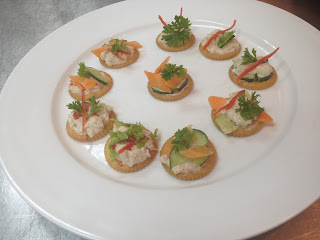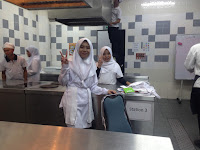INTERNATIONAL CUISINE - WEEK 1 (INTRODUCTION ABOUT INTERNATIONAL CUISINE)
The
introduction about the International Cuisine
- - An international cuisine is
a cuisine that is practiced around the world. A cuisine is a
characteristic style of cooking practices and traditions, often
associated with a specific region, country or culture. To become a global
cuisine, a local, regional or national cuisine must spread around the world,
its food served worldwide. There have been significant improvements and
advances during the last century in food preservation, storage,
shipping and production, and today many countries, cities and regions have
access to their traditional cuisines and many other global cuisines.
History
of International Cuisine
- Cuisine (from French cuisine,
"cooking; culinary art; kitchen"; ultimately from Latin coquere,
"to cook") is a characteristic style of cooking practices and
traditions, often associated with a specific culture. Cuisines are often named
after the geographic areas or regions that they originate from. A
cuisine is primarily influenced by the ingredients that are available locally
or through trade. Religious food laws, such as Islamic dietary laws and Jewish dietary laws, can also exercise a
strong influence on cuisine. Regional food preparation traditions, customs and ingredients often
combine to create dishes unique to a particular region.
Cuisine can be stated as the foods and methods
of food preparation traditional to a region or population. The
major factors shaping a cuisine are climate, which in large measure
determines the native raw materials that are
available, economic conditions, which affect trade and can
affect food distribution, imports and exports, and religiousness or sumptuary
laws, under which certain foods are required or proscribed.
Climate also affects the supply of fuel for cooking; a common
Chinese food preparation method was cutting food into small pieces to cook
foods quickly and conserve scarce firewood and charcoal. Foods preserved for winter
consumption by smoking, curing, and pickling have remained
significant in world cuisines for their altered gustatory properties
even when these preserving techniques are no longer strictly necessary to the
maintenance of an adequate food supply.
New cuisines continue to evolve in contemporary times. An example
is fusion cuisine, which combines elements of
various culinary traditions while not being categorized per any one
cuisine style, and generally refers to the innovations in many contemporary
restaurant cuisines since the 1970s.
CONTENTS
Briefing
about the class
-
In
the week 1, chef Putra just do the briefing about the class. He inform about
the subject International Cuisine and the assignment for this class. Other than
that, he was tell us about how to do in the this class , what exactly we do in
the class and the rule in this class.
The
assignment and final exam marks
-
Assignment
1 (10%)
-
Assignment
2 (10%)
-
Assignment
3 (10%)
-
Assignment
4 (20%)
-
Mid
Term (10%)
-
Final
Exam (40%)
The
COD and SOD for each week
COD
|
WEEK
|
SOD
|
FAISAL & SHAKIR
|
4
|
RACHVY &
JACK
|
ATIKA & ERMA
|
5
|
DESMOND, MEO & RIAN
|
FAKRUL & AIN
|
6
|
ERRA, SHAFIQ
& SHARIF
|
NAJWA & NUR AFIQAH
|
7
|
IZZAT, SYAWAL & M FIRDAUS
|
FADLY & ARIF
|
8
|
FAISAL &
SHAKIR
|
IZZAT, SYAWAL & M.FIRDAUS
|
9
|
FADLY & ARIF
|
ERRA, SHAFIQ & SHARIF
|
10
|
FAKRUL &
AIN
|
DESMOND, MEO & RIAN
|
11
|
NAJWA & NUR AFIQAH
|
RACHVY & JACK
|
12
|
ATIKA &
ERMA
|
CONCLUSION
-
In
the end of this class, I can learn a little bit of this subject, what exactly
the meaning of the International Cuisine also I can know what does the meaning
of COD and SOD. For COD, its mean chef on duty that is student will be in
charge the class for that week to be a leader for the class and lead the other
student to do their task was given from COD and for SOD, its mean service on
duty



Comments
Post a Comment